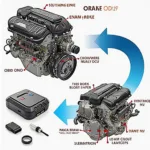The OBD2 misfire monitor is a critical component of your vehicle’s onboard diagnostic system. It constantly monitors engine performance, looking for misfires that can reduce fuel efficiency, increase emissions, and potentially damage your catalytic converter. Understanding how it works can help you diagnose and address engine problems more effectively. Let’s dive in.
What is an OBD2 Misfire Monitor?
The OBD2 misfire monitor uses crankshaft position sensor data to detect irregularities in engine rotation speed. These irregularities often indicate a misfire, which is the incomplete combustion of the air/fuel mixture in a cylinder. When a misfire occurs, the crankshaft’s rotational speed fluctuates. The monitor recognizes these fluctuations and, if frequent enough, triggers a diagnostic trouble code (DTC) and illuminates the check engine light.
How Does the OBD2 Misfire Monitor Work?
The monitor works by comparing the actual crankshaft speed with the expected speed. The expected speed is based on the engine’s firing order and the number of cylinders. If the actual speed deviates from the expected speed beyond a certain threshold, the monitor registers a potential misfire. The system also distinguishes between random and specific cylinder misfires, providing more precise diagnostic information. This information helps pinpoint the source of the problem, whether it’s a faulty spark plug, a clogged fuel injector, or a compression issue. The ilc professional obd2 wifi scan tool can help you quickly identify these codes.
Types of Misfire DTCs
Several DTCs are associated with misfires. These codes typically start with P0300, followed by a number indicating the specific cylinder experiencing the misfire (e.g., P0301 for cylinder 1, P0302 for cylinder 2, and so on). A P0300 code indicates a random misfire, meaning the misfire is not consistently occurring in a single cylinder.
Why is the OBD2 Misfire Monitor Important?
The OBD2 misfire monitor plays a crucial role in maintaining engine health and reducing emissions. Untreated misfires can lead to several problems:
- Reduced Fuel Economy: Unburned fuel is wasted, leading to decreased fuel efficiency and higher fuel costs.
- Increased Emissions: Raw fuel exiting the engine increases harmful emissions, contributing to air pollution.
- Catalytic Converter Damage: Excess fuel entering the catalytic converter can overheat and damage it, requiring costly repairs.
“Regularly monitoring for misfires is essential for preventing costly repairs and minimizing environmental impact,” says automotive expert, John Miller, ASE Certified Master Technician. “Using an ilc obd2 obd wireless car code reader can help you catch these issues early.”
Common Causes of Misfires
Several issues can trigger the OBD2 misfire monitor:
- Faulty Spark Plugs or Wires: Worn-out spark plugs or damaged spark plug wires can prevent proper ignition of the air/fuel mixture.
- Clogged or Leaky Fuel Injectors: A clogged fuel injector restricts fuel flow to the cylinder, while a leaky injector can deliver too much fuel.
- Vacuum Leaks: Leaks in the intake manifold or vacuum hoses can disrupt the air/fuel mixture.
- Low Compression: Worn piston rings or valves can lead to low compression in the cylinder, preventing efficient combustion.
- Faulty Ignition Coil: A faulty ignition coil can prevent the spark plugs from firing correctly.
How to Diagnose and Fix Misfires
If your check engine light illuminates and you suspect a misfire, you can use an OBD2 scanner, such as the ilc obd2 obd wireless car code reader scan tool, to read the specific DTC. Once you have the code, you can begin to troubleshoot the problem. This can involve checking the spark plugs, fuel injectors, vacuum lines, and compression. “A professional obd2 scanner is an invaluable tool for any car owner,” adds Dr. Emily Carter, Automotive Engineer. “It empowers you to understand your vehicle’s health and address issues proactively.”
Conclusion
The OBD2 misfire monitor is a crucial system for maintaining engine performance, reducing emissions, and protecting your catalytic converter. Understanding how it works and the common causes of misfires can help you address these problems effectively and keep your car running smoothly. If you experience a misfire, use a professional obd2 scan tool to diagnose the issue promptly and avoid further damage.
FAQ
- What does a P0300 code mean? A P0300 code indicates a random misfire.
- Can a misfire damage my engine? Yes, untreated misfires can damage your catalytic converter and other engine components.
- How do I fix a misfire? Fixing a misfire requires diagnosing the underlying cause, which could range from faulty spark plugs to vacuum leaks.
- What is the OBD2 misfire monitor? It’s a system that detects misfires by monitoring crankshaft speed fluctuations.
- Why is my check engine light on for a misfire? The check engine light illuminates when the OBD2 system detects a misfire that exceeds a certain threshold.
- Can I drive with a misfire? It’s not recommended, as it can damage your car and reduce fuel efficiency.
- How can an OBD2 scanner help with misfires? An OBD2 scanner provides the specific DTC, helping pinpoint the cause of the misfire.
Need further assistance? Contact us via WhatsApp: +1(641)206-8880, Email: [email protected] or visit us at 789 Elm Street, San Francisco, CA 94102, USA. Our customer service team is available 24/7.
